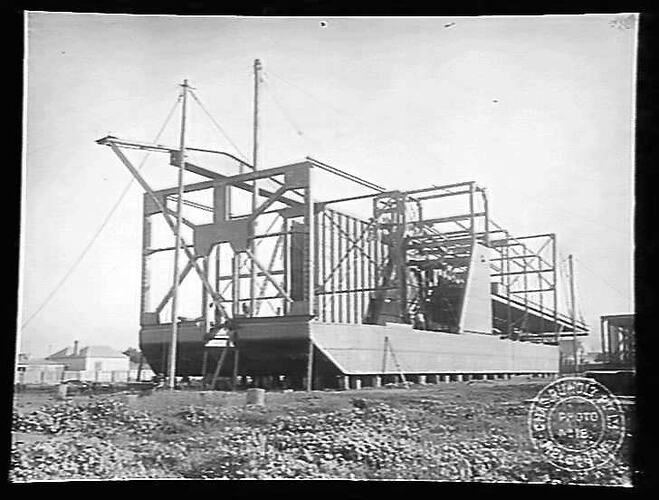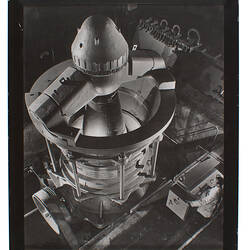Summary
Glass negative depicting the Kampong Kamunting dredge under construction.
Prior to the invention of cellulose nitrate film in 1903, photographic emulsion was supported on glass. Two different formats were developed for creating these supports - collodion wet plate negative (early 1850s) and the gelatin dry plate (1871) - however, both formats are commonly referred to as 'glass negatives.' The use of glass negatives greatly increased interest in photography and the gelatin dry plate eventually superceded the collodion wet plate by virtue of being more convenient.
As the collodion wet plate appears to have only been in use until the 1880s it seems likely that this glass negative is an example of the gelatin dry plate method.
Stamped on the bottom right corner of the image is the name of Charles Ruwolt's company. Charles Ernest Ruwolt (1873-1946) was a German born engineer and industrialist. In 1902 he opened an iron foundry in Wangaratta and in 1928 the company merged with that of Isaac Stevenson, soon became the leading manufacturer of mining dredges.
Charles Ruwolt Pty. Ltd. (registered in 1910) moved to Melbourne in 1914 where it became a public company (Ruwolt & Co.) in 1920, although Ruwolt and Stevenson retained a controlling interest, and by 1938 the company was one of the largest engineering companies in Australia. During World War II the company was used to manufacture field artillery.
In 1948, two years after Ruwolt's death, the company was bought by Vickers Limited and renamed 'Vickers Ruwolt.' Vickers Ruwolt operated as part of Vickers Australia and, when the company in 1983 with BHP's Commonwealth Steel Company Limited in Newcastle, as part of Comsteel Vickers Limited.
Vickers Ruwolt was closed in 1985 although the Ruwolt name was briefly resurrected in 1986 when ANI took over Comsteel Vickers and renamed it ANI Ruwolt. However the Ruwolt name was dropped in 1995. The Vickers Ruwolt site was redeveloped and it now Victoria Gardens, Richmond.
The same dredge can be seen from different angles at MM 11657, 11667, 11666, 11665 & 11661.
Description of Content
Glass negative depicting a large piece of machinery under construction.
Physical Description
Full plate silver gelatin glass negative.
More Information
-
Collection Names
-
Collecting Areas
-
Acquisition Information
Donation from Vickers Ruwolt Pty Ltd, circa 1986
-
Place & Date Depicted
-
Format
Glass Negative, Whole Plate, Black & White
-
Inscriptions
Circular stamp at bottom-right of negative: 'CHAS. RUWOLT PTY LTD MELBOURNE PHOTO 18' Entered in hand-written catalogue as '18 | Kampong Kamunting Dredge No. 1 - Front View | Kampong Kamunting Dredging Company' Entered in hand-written subject index under "DREDGERS AND DREDGER DETAILS (NEGATIVES) as '18 | 2-8-28 | Kampong Kamunting Dredge No. 1 - Front View | Kampong Kamunting '
-
Classification
Manufacturing & industry, Engineering products, Dredging equipment
-
Category
-
Discipline
-
Type of item
-
Image Dimensions - Negative/s
215 mm (Width), 164 mm (Height)
-
References
David Chesterfield, Company Secretary (Bradken Limited), 'Charles Ruwolt Pty Limited - A Brief History,' at: [Link 1] accessed: Sept 3, 2012 Hayes, G., 'Ruwolt, Charles Ernest (1873-1946)', Australian Dictionary of Biography, National Centre of Biography, Australian National University, [Link 2] accessed 3 September 2012. Greta Bahnemann, 'The Preservation of Glass Plate Negatives,' at: [Link 3] accessed: Sept 3, 2012 'Ruwolt, Charles Pty Ltd' at: [Link 4] , accessed: Sept 3, 2012
-
Keywords

